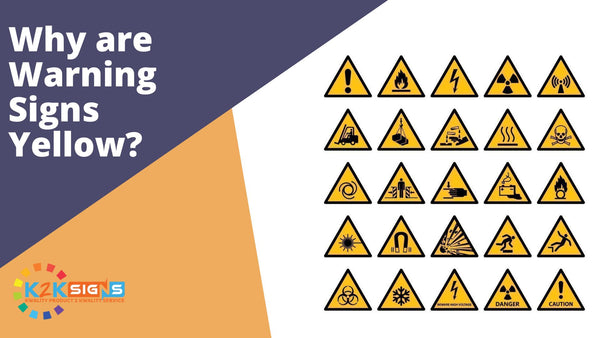Why Are Warning Signs Yellow?
When we think of warning signs, the vibrant colour yellow immediately comes to mind. From road signs to industrial settings, the prevalence of yellow in cautionary signage is no coincidence.
This article explores the multifaceted aspects of yellow warning signs, from its historical roots to the science behind its effectiveness and its global standardisation.
The Impact of the Colour Yellow
When it comes to the colour yellow, its impact on the human mind is particularly noteworthy. Yellow is often associated with feelings of energy, happiness, and optimism.
As one of the most attention-grabbing hues, yellow demands immediate notice and can stimulate a sense of alertness and focus. In the context of warning signs, the psychology of yellow plays a crucial role. The bright and vibrant nature of yellow naturally draws our attention, making it an ideal choice for cautionary symbols.
When we encounter yellow warning signs, our brains quickly recognise the colour and register its association with caution, danger, or potential hazards. This instinctual response is vital in conveying critical messages swiftly, promoting safety in various environments.
Overall, the psychology of colour, particularly when it comes to yellow, underscores its effectiveness in warning signage. By tapping into our innate reactions to colour, yellow enhances visibility, promotes immediate recognition, and fosters a safety-conscious mindset.
As we encounter yellow warning signs daily, let us appreciate the psychological impact of this vibrant hue and its significant role in keeping us informed and protected.
History of Warning Sings
Warning signs have a long history dating back to ancient civilisations, where visual markers were used to warn of potential dangers.
More recently, the rise of transportation systems and industrialisation necessitated standardised warning signs for public safety. The early 20th century marked the development of a universal system for road signs, and the use of symbols and colours, such as the bright yellow hue, became prevalent.
Today, warning signs play a vital role in promoting safety, utilising clear communication and easily recognisable symbols to protect individuals from potential hazards in various settings.
The Science Behind Yellow Warning Signs
The science behind yellow warning signs lies in the colour's unique properties that enhance visibility and grab immediate attention.
Yellow is one of the most noticeable colours in the visible spectrum, making it stand out against most backgrounds and lighting conditions. This high visibility is crucial in warning signs, as it ensures that the message is easily seen and comprehended by individuals, even from a distance or in low-light situations.
The human eye is susceptible to yellow wavelengths, and the colour evokes a rapid response in our visual system. When we encounter a yellow warning sign, our brain processes the colour quickly, triggering a sense of urgency and alertness. This innate response is beneficial when immediate recognition of cautionary messages is essential for safety.
Moreover, the combination of yellow and black, commonly used in warning signs, further enhances their effectiveness. The high contrast between the bright yellow background and the bold black symbols or text creates visual prominence, making the information on the sign easily readable and recognisable.
Global Standardisation
Global standardisation of yellow warning signs remarkably promotes consistency and a universal understanding of cautionary messages.
Regardless of the country or culture, using yellow as a warning colour has become a recognised and standardised practice worldwide. This consistency allows travellers, tourists, and locals alike to easily comprehend the message conveyed by yellow warning signs, irrespective of language barriers or unfamiliar surroundings.
The widespread adoption of yellow as a warning colour can be attributed to various factors. One of the key reasons is its high visibility and the human eye's sensitivity to this vibrant hue.
Yellow stands out against most backgrounds and lighting conditions, making it an ideal choice for capturing attention and conveying critical messages swiftly. Yellow warning signs are also deeply ingrained in established international road safety standards, such as those set by the Vienna Convention on Road Signs and Signals, further contributing to global standardisation.
Moreover, the consistency of yellow warning signs across borders and cultures fosters travellers' sense of security and familiarity. When navigating unfamiliar territories, seeing familiar yellow warning signs promotes a feeling of reassurance and safety.
The universal recognition of yellow as a warning colour contributes significantly to a more cohesive and safety-conscious global community.
Conclusion
The ubiquity of yellow in warning signs is no coincidence. From its psychological impact to its high visibility, yellow effectively captures attention and promotes safety in various settings.
Understanding the science, history, and cultural significance behind yellow in warning signs provides valuable insights into this bright hue's critical role in keeping us safe.
As we continue encountering yellow warning signs on our daily journeys, let us appreciate this cautionary hue's power and role in safeguarding our lives.

